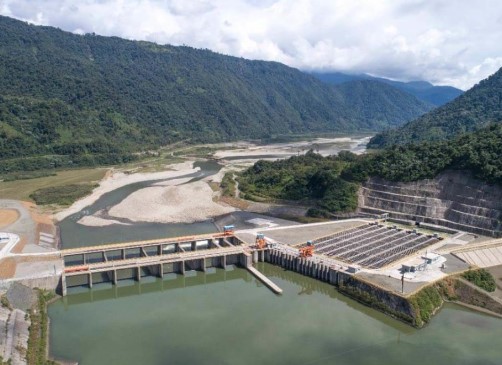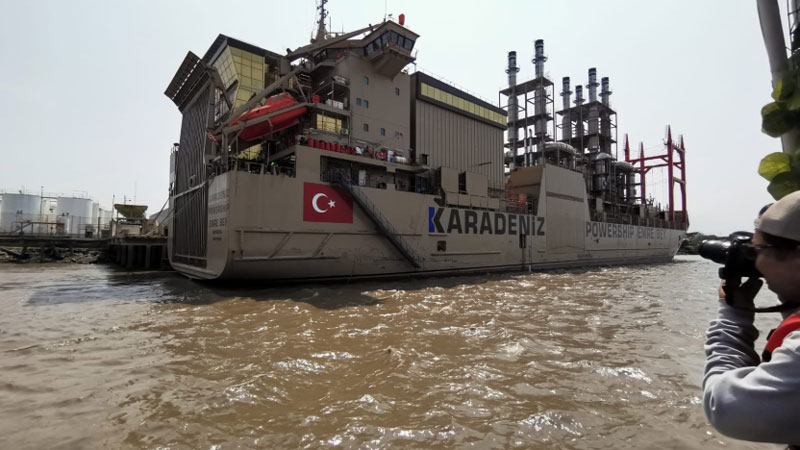Ecuador seeks outside help to solve problems at the Coca Codo hydroelectric plant
By Lorena Baires
The Coca Codo Sinclair Hydroelectric Power Plant, built by the Chinese company SinoHydro and described as the largest engineering project in Ecuador’s history, is in danger of collapse. A series of structural defects, the accumulation of sediments due to the lack of floodgate filters, as well as a process of river erosion, are threatening to bring power generation at the facility to a standstill.

The Coca Coda Sinclair hydroelectric plant on the Coca River, east of Quito.
In mid-June, representatives of Ecuador’s Power Corporation (CELEC) and the U.S. Army Corps of Engineers (USACE) met in Quito to develop a plan to stop the advance of regressive erosion, which threatens the power plant.
USACE personnel made their first technical evaluation of the hydroelectric plant in 2021 and have since worked with CELEC, toward finding a solution to the river’s erosion and to protect the facility’s infrastructure. More recently, USACE members have been working to implement emergency measures in at-risk areas along the Coca River and expanding monitoring to predict and reduce power outages.
“The U.S. Army Corps of Engineers brought in a variety of outside government agencies to […] help better understand the Coca River sedimentation challenges,” Adriel McConnell, USACE Latin America Project Manager, said on the Embassy’s X account. “Our goal is to better understand how to stabilize this new river profile, between the collapse and the catchment itself, to maintain the long-term reliability of the power system.”
In a little more than three years, between June 2020 and January 2024, the erosion caused the loss of 508 hectares of native forest and farmland, and the pace of deforestation is increasing, according to the nongovernmental organization Conservación Amazónica.
The greatest geological impact of the erosion occurred in 2021 with the disappearance of the San Rafael Waterfall, 20 kilometers from the Coca Codo catchment area that diverts the flow to the hydroelectric plant. The demise of the waterfall and the subsequent river course change caused accelerated erosion upstream which, in turn, created landslides and the collapse of the riverbanks, experts say.

Erosion of the Coca River, near the hydro plant, has destroyed hundreds of hectares of forests and farmland.
“The problem started with failure to consider dredging of the thick sediments, including stones of more than 20 centimeters. This material filled the reservoir, causing the issues we are facing today,” Dr. Carolina Bernal, a research professor at Ecuador’s National Polytechnic School, said. “The lower part was filled with all these very thick sediments and now in the upper part the fine sediments are forming islands, with trees up to four or five meters high.”
Construction of the hydroelectric plant began in July 2010 and was completed in November 2016. At its inauguration, former Present Rafael Correa claimed Coca Coda would provide all of Ecuador’s energy needs for 30 years.
Within two years, however, the first construction defects appeared: 7,648 cracks in the turbines as well as cracks in the concrete structure around the turbines. At the same time, the reservoir that feeds the turbines showed the first signs of unexpected sediment build-up.
“If sediment gets into the turbines, the turbines are damaged,” Bernal added. “When the erosion reaches the catchment area, the riverbed will deepen. Then the collector tunnel and the water will no longer be at the same level. The water will be lower and will not be able to enter the catchment.”

Government officials on a recent visit to the Coca Coda Sinclair hydroelectric plant.
An inspection by a German consulting team in 2019, found more than a dozen construction defects at the dam and generation plants, ranging from lack of proper studies before the project began construction to the use of interior steel and concrete. One of the biggest problems, the team said, was an “inexcusable” miscalculation of flow-rate of the Coca River, which they said was over-estimated by almost 50%. The facility could never generate the amount of electricity estimated at the start of construction, the consultants claimed.
SinoHydro denied the charges, claiming most of the problems were the fault of Ecuadorian planners or factors beyond their control.
In addition to poor planning and construction defects, the project was plagued by corruption. Court cases continue against a former vice president and three former government ministers charged with accepting bribes from SinoHydro. Sources in Ecuador’s Energy Ministry say that the corruption led to lack of oversight during construction.
The Coca River erosion is advancing rapidly in the direction of the plant’s reservoir, also endangering oil pipelines near highway E45. On three occasions, pipelines have required relocation due to the erosion.
“We are only 6.8 km from critical infrastructure. If urgent actions are not taken, we will face continuing electric blackouts in the country,” Dr. Inti Grungberg, an Ecuadorian environmentalist and scientist, told news website Ecuador en Vivo. “It is crucial that the government act immediately to solve this problem, before it’s too late.”
On July 2, the Coca Coda power plant was forced to shut down entirely due to an increase in sediment. To avoid a generalized blackout, CELEC increased hydro generation at facilities near Cuenca and purchased additional energy from Colombia, while remediation efforts went forward.
The problem that could permanently paralyze Coca Coda are the thousands of cracks in the turbines and powerhouse water distributors. This led to a legal claim filed CELEC against SinoHydro.
“The regressive erosion between the disappeared San Rafael Waterfall and downstream is eating up the Coca River valley,” Bernal said. “This is causing the destruction of the oil transportation system as well as damage to Coca Coda. Roads have been destroyed, and populations are isolated, forcing internal migration.”
Among Ecuador’s options to protect the Coca Codo Sinclair is the creation of a permeable dam together with USACE, which was slated to begin in mid-August, CELEC said via X.
















